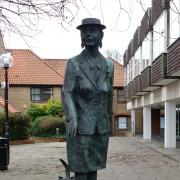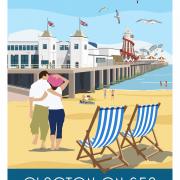Bill Loram gets out on the water around the coast of Essex to get a hands on experience of our maritime history through the Colne Smack & Barge Race and the West Mersea Dredging Match

If you are ever inquisitive as to where the sport of sailing evolved from, and what it would be like to step back in time and walk the wooden decks of the days of sail, then Brightlingsea is the place to be in early September.
The Colne Smack and Barge Race followed by the West Mersea Dredging Match provide a taste of yesteryear with the spectacles of gaff rig racing and oyster fishing.
To the uninitiated, smack and barge may sound like the activities of unruly infants, and dredging one of those activities best left to people growing prize vegetables in their allotment.
In fact the smack was a traditional gaff cutter or ketch rigged fishing boat, and in the case of the Colne, these were mainly oyster fishing boats, working the oyster beds that had been in the river since the days of Old King Cole and beyond.
The barges are the Thames barges, the iconic sailing coastal traders that shipped everything from hay, bricks and grains into London, and took the rubbish out on the way out of the Thames estuary.

These were much like the Severn troughs, but the Thames barges managed to survive better in working life - the last trade journey being made on the Cambria in 1970. This overlapped with increasing interest in holding on to the old working boats.
The Old Gaffers Association was formed in 1963 at Maldon, now recognised as the de facto Thames barge capital.
I booked myself aboard as crew on the recently restored second class Essex smack Priscilla CK437, which is 39ft from stem to rudder and 43ft overall including bowsprit and counter stern overhang.
Built in 1890 she was the second smack built at the yard that closed its doors in 1988 and the oldest surviving boat from the yard that produced so many workboats for the fishermen of the town and the River Colne.
The Priscilla was almost certainly paid for by prize money from crewing on gentlemen's racing yachts, with the fishermen taking to the water on their own account after the summer season to dredge for oysters in the Colne and Blackwater estuaries, with 'stowboating' for sprats starting in December.

The other trades that were regularly dipped into by the Essex fishermen were smuggling and salvage work - towing shipwrecks back to port for salvage rights.
For both of these they needed fast, weatherly boats - the first to escape the customs cutters, and the second to beat anyone sailing hard for the same prize.
In 1819, when the Waterloo veteran the Marquis of Anglesey wanted an unbeatable yacht, he had to pull the Colne boatbuilder and his brothers out of goal for him to build it.
As a convicted smuggler, he knew how to build fast yachts and the Pearl was the result. The contest between Pearl and the Lymington-built Arrow in 1825 is often seen as the start of modern yacht racing.
The growth in popularity of yacht racing saw crews from Brightlingsea, Wivenhoe and Rowhedge on the Colne on the large yachts competing on the south coast and east coast regattas, as well as J class yachts of the Shamrock and Endeavour America's Cup challenge.

This was the history I was stepping into when I stepped aboard Priscilla as crew for the day.
With a 07.30 start for the barges, and the smacks racing for the start line 30 minutes later, it was an early start, but whoever ordered the weather had done a good job.
The early morning mist over the marshes of Brightlingsea Creek gave an ethereal feel to the morning, as the dusky pinks gave way to clear azure skies above a combined fleet of 20 smacks and barges readying for the race.
Priscilla had a long history as a working boat and only stopped fishing commercially in 1975.
But an unfortunate incident in a muddy creek broke her back and so she was sheathed in ferro cement to give her more strength in the early 80s, which allowed her to take part in smack regattas and rallies along the Thames estuary, before being sold to new owners in the Solent and then, in an increasingly dilapidated state, ended up in Bristol Marina.

There she became a liveaboard, before being hauled out and become a liveaboard ashore, until unpaid yard bills almost condemned her to be broken up.
A telephone call to the Pioneer Trust in Brightlingsea provided Priscilla with a temporary saviour, for the price of £1. She was loaded onto a lorry, and with her counter stern wobbling dangerously along the M4 and a silver birch tree that was growing out of the starboard quarter rooted in the composting timbers standing proud of the decks, she made her way back to her Essex home in 2000.
The tree was replanted and is still growing strong.
Now, after funding being put in place, a three-year build and a relaunch by the Countess of Wessex, Priscilla is back on the water and keen to show her paces for people to learn how to sail these tan sailed workhorses of the Victorian era.
With light airs, the barges glided into their starting positions, for a course that would send them up to the Colne Bar buoy to then run down to Clacton Pier and then harden up in front of the wind farm and head off south to Wallet Spitway, and back home again.

A century ago this would be a small gathering of smacks and barges, but today it is an impressive collection of iconic maritime history on the water. Something to taste and savour, as you never know when it might disappear completely, and in taking part you are privileged to sample living history.
I joined the crew of Mark Allen, shipwright and project manager of the Priscilla restoration at Pioneer Trust; Dunstan Pugh, who worked as an apprentice on the restoration; and George Brown, who works locally on the Gunfleet windfarms and was a keen follower of the smack and restoration journey.
Priscilla is coded for 10 people, which includes a skipper and qualified crew, and Pioneer Trust is keen to make sailing history available to all. Charter guests are encouraged to be as hands-on as they are happy with.
'We want to get people afloat to get them to experience a sailing smack and get them interested, to keep the smacks going into the future,' says Mark, as we turn at the first mark and head towards the end of Clacton Pier, with the wind behind us and Dunstan balancing in the bows with a boathook to goosewing the staysail on the run.

In search of oysters
If the day on the Priscilla was emulating the fishermen and barge skippers of yesteryear who wanted to prove who was fastest, then the day of the West Mersea Dredging Match was emulating how the fishing smacks went about their main trade in the estuary.
Old King Cole, the Celtic chief of Colchester, would have probably eaten native oysters from the same beds. The Romans did, and their shells have been found along Hadrian's Wall.
But boom time for the oyster trade was when the railways opened up a fast route to London and they became a cheap food for the working man in London.
With a Force 3-4 south-westerly we bowled over to the oyster beds of the Tollesbury & Mersea Native Oyster Fishery Company in Maria CK21, 47ft on deck with a 20ft bowsprit, to the competition grounds.

She was built in 1866 but has been owned and rebuilt by Paul Winter for 25 years, after an obsessive search to track her down. Maria is the only smack for charter for the competition with the atmosphere being a family event with emphasis on the fun side, although there is always a keen eye for doing better than the rest.
The West Mersea Dredging Match is unique. You can go to oyster festivals at Whitstable or Falmouth, but there is nowhere in the country that you can get first-hand experience of how to fish for oysters.
It all started, as most good things do, as a conversation in a pub between like-minded people nearly 40 years ago. They wanted to preserve the old methods of harvesting oysters under sail.
From small beginnings, it has flowered into an event that has drawn the likes of Jamie Oliver to judge the weigh in at the end of the match.
As well as the bigger smacks and bawleys, there is a class of bumpkins - small traditional open fishing boats - that also make up the fleet. The match area is a box on the native oyster beds, with two hours to dredge the most native oysters using only sail and oar.
The dredge is a netting over a metal frame that drags along the oyster bed and is hurled out on the windward side of the boats. Done well, with the right amount of canvas up, and the helmsman does not have to touch the tiller as the dredges will steer the smack.
When hauled up, all the mud and other sealife is sorted on board, oysters put in the crate and the rest returned to the briney.
With boats being judged on style and old school seamanship, as well as the weight of native oysters, there is constant tending to the sail trim to get the optimum speed for dredging. Luckily Paul had most of his race crew on board, so boat handling was not a problem.
Under a blue azure sky, at 13.00 the Blue Peter was lowered on the Foreman Smack, and competitors made a dash to Packing Shed Island, a twmp of mud with a shed on it, where seafood lunches - including oysters - were served, and employees in the oyster fisheries and bars then had their own Oyster Opening competition before the many prizes were handed out.
We didn't manage any trophies, but we were all winners by basking in the glorious weather, and continuing the long traditions that stretch back through the centuries — keeping maritime history alive and kicking.
Find out more
Useful links to find out more about the Colne Smack & Barge Race and the West Mersea Dredging Match.



























